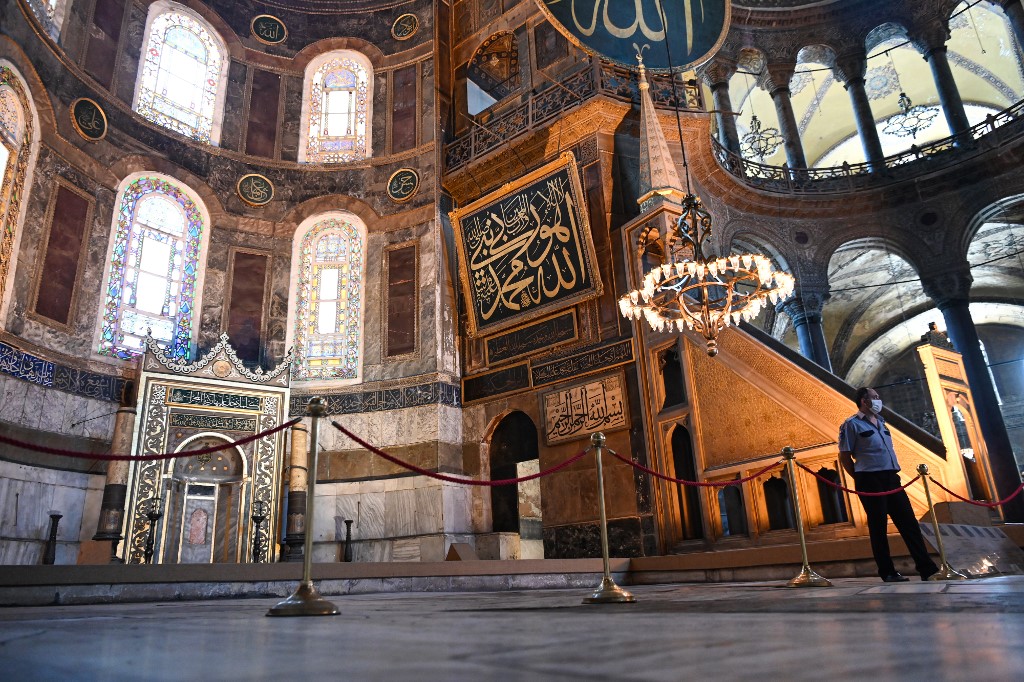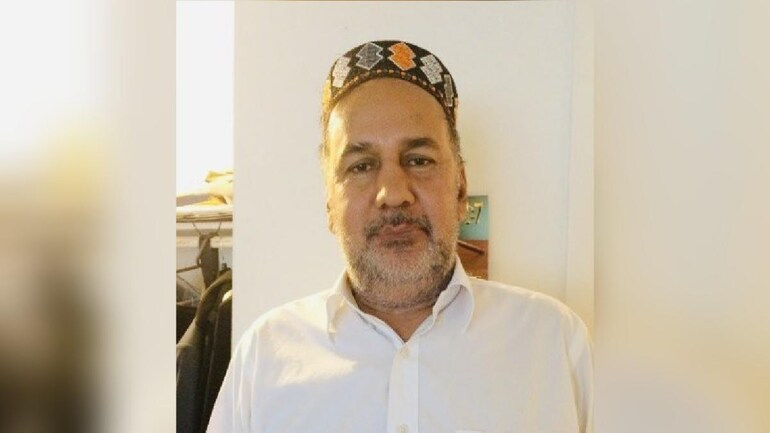Even 86 year later, debate still swirls around the decision taken in 1934, and has echoes in Erdogan's decision to revert it to a mosque

People fly the Turkish flag outside the Hagia Sophia in Istanbul on 15 July (AFP)
As expected, Turkey’s Council of State earlier this month repealed the 1934 cabinet decision that turned the Hagia Sophia into a museum.
In doing so, it overturned a decision by the founding fathers of the republic, including Mustafa Kemal Ataturk; Ismet Inonu, a Turkish general and statesman who served as the second president of Turkey from 1938 to 1950; and Celal Bayar, third president of Turkey who served from 1950-60.
In an hour, President Recep Tayyip Erdogan signed a decree, and the Hagia Sophia was transferred to the Islamic affairs directorate and opened to prayers, more than eight decades later. On Friday, the first Jumma prayers will be held there in 86 years.
It was a great achievement for Whittemore to convince rich Americans to save Byzantine artefacts in Istanbul
But how did the Hagia Sophia become a museum in the first place? On 12 June 1929, eight rich and famous Americans met at the Tokatliyan Hotel on Istanbul’s Istiklal Street. The Byzantine Institute of America, which changed the Hagia Sophia’s destiny, was established during a dinner that night. The real mastermind was Thomas Whittemore, a socialite and academic with a passion for Byzantine art.
Whittemore had a social network ranging from American riches to Russian princes, including painter Henri Matisse and literary critic Gertrude Stein. Whittemore was known for his oversize scarfs and his love for hats. He was religious, gay and vegetarian.
The world was progressing towards the Great Depression, and it was a great achievement for Whittemore to convince rich Americans to save Byzantine artefacts in Istanbul. The greater achievement, two years later, was to get permission from Ankara to uncover the plastered Byzantine mosaics at the Hagia Sophia.
The Turkish cabinet issued a decision on 7 June 1931 for the work, signed by Ataturk and Inonu. According to the Byzantine Institute’s archives, Joseph Grew, then the US ambassador to Ankara, played a central role in obtaining the authorisation. Grew and Ataturk knew each other well; in now-famous footage, they jointly addressed the American public in 1927 to present the "new Turkey".
It was also a time when former enemies, such as Greece’s former prime minister, Eleftherios Venizelos, were getting closer to Turkey. Ankara and Athens signed a peace and cooperation deal in 1930 after Venizelos paid a visit to Turkey. He later nominated Ataturk for the Nobel Peace Prize. Turkey was looking to join the League of Nations in an attempt to balance its foreign relations against rising fascism.
Secretive decision
Ankara's permission to uncover the mosaics was welcomed in the West with fanfare, but Turkish people were clueless. The decision was taken in such secrecy that Turkish newspapers only learned of it two months later, thanks to a New York Times report.
Was Erdogan right to declare the Hagia Sophia a mosque?
Read More »
The same day, Turkish newspapers ran reports of two American airmen flying from New York to Istanbul, and of a letter sent by Ataturk to the US president. There were remarks by relevant local officials underlining that the work on the mosaics wouldn’t change the features of the mosque.
That first year, Whittemore and his staff uncovered the mosaics in the halls. But the mosque was still open for prayers, and next was the real issue: how would they uncover the mosaics with icons inside the mosque?
Coincidentally, Ataturk invited Whittemore to a historical congress in Ankara. He was welcomed by Ataturk’s adopted daughter, Zehra, who later died after studying in Britain by committing suicide or “falling from a train” while en route to France.
Ataturk met Whittemore in a publicised meeting, where he listened to the American scholar about the Byzantine mosaics and took his advice to send Zehra to Britain for English language education. But the picture of Ataturk with Whittemore wasn’t enough to subdue the public.
Gossip about the excavation was rampant, triggering another public attempt by politician Halil Ethem, a co-founder of the Byzantine Institute, to calm the masses. Appearing with Whittemore at the Hagia Sophia, Ethem said that nothing was harmed in the mosque and that the icons had not originally been banned in Islam.
Bombshell lands
The first official document to start the conversion of the Hagia Sophia into a museum was a letter dated 25 August 1934, written by then-Education Minister Abidin Ozmen to the prime minister's office.
“Upon the great verbal order I received, I hereby present one copy of the order that requires planning to put Hagia Sophia mosque into a museum,” Ozmen wrote. The prime ministry immediately created a commission and drafted a to-do list within two days.
Ozmen revealed the details of the oral order after his retirement in 1949, while he was paying a visit to the Hagia Sophia museum’s general manager, Muzaffer Ramazanoglu: “It was said in an academic way, chiefly by Ataturk, that instead of keeping it as something [that] only belongs to one religion and class, that turning Hagia Sophia into a museum that is open to visitors from all nations and religions would be suitable.”
 The Hagia Sophia in Istanbul is pictured on 2 July (AFP)
The Hagia Sophia in Istanbul is pictured on 2 July (AFP)
The news of the conversion decision landed like a bombshell. Everyone was surprised. The manager of museums mentioned in the news reports didn’t even know what was happening.
The sudden decision was even criticised by pro-Ataturk Cumhuriyet daily newspaper in a front-page article: “We have to confess that we are continuing to get astonished as we read the newspapers, which report that Hagia Sophia will be organised as a museum. We constantly ask ourselves this question: what museum? Hagia Sophia itself is the most beautiful museum, and even alone is a better historical monument. We cannot comprehend the conversion of this monument into a museum.”
A message to the West
The cabinet decision followed. On 24 November 1934, the cabinet decreed that turning the Hagia Sophia into a museum would make all of the eastern world happy, giving another educational institute to humanity.
There have been many theories on what motivations led to the conversion. Some said it was a message to the US, and in general to the West, that the new regime in Turkey was secular and peaceful. Others claimed it was a gesture to the Balkan Pact, signed that year with Greece, Yugoslavia and Romania.
The public and newspapers weren't able to raise their voices, and the state, without questioning anything, used all its resources to make it happen
Whittemore, meanwhile, continued his work until the end of the 1940s, uncovering the mesmerising mosaics at the Chora Church in Istanbul after completing his task at the Hagia Sophia. He died in Washington in 1950 on his way to the State Department to meet Allan Dulles, the first civilian CIA director. Some claimed that Whittemore was also an intelligence source. He was holding an album of Hagia Sophia mosaics when he passed away.
Whatever the reason, the decision to turn a building essential to Istanbul’s religious and social life, which had served as a mosque for more than four centuries, without any outside input came as a surprise, and caused trauma among the religious segments of society.
That’s why it has long been an exciting dream for religious conservatives to reopen the Hagia Sophia as a mosque.
Just because the leader of the country deemed it appropriate, Istanbul’s largest mosque was turned into a museum overnight. The public and newspapers weren’t able to raise their voices, and the state, without questioning anything, used all its resources to make it happen.
Debate continues
Even 86 year later, debate still swirls around the decision taken in 1934. And however tragic it may be, Turkey’s decision-making mechanisms still work with 1934 technology, as evidenced by the latest move to again change the status of the Hagia Sophia.
The president had not taken a single step on the Hagia Sophia for two decades, responding to requests by saying people should first fill the mosque next door, and denouncing calls to turn the Hagia Sophia into a mosque as provocation.
Then, he suddenly he gave a green light to the conversion. The Council of State, whose chief justice was appointed to the position after voting to cancel Istanbul’s local elections last year, and which has rejected similar requests three times since 2005, unanimously repealed the previous cabinet decision and turned the Hagia Sophia into a mosque.
Some believe the goal was to distract from Turkey’s economic problems or to stop electoral bleeding; others say it aimed to send a message abroad.
With this decision-making mechanism reminiscent of the 1930s, and amid the applause of the same people who are grateful to lift the curse of Mehmed II cited in the Hagia Sophia’s endowment charter, a university belonging to a 40-year-old conservative foundation has been closed; people have been put in prison by political orders; and elected mayors have lost office.
Turkey in 1934, when the Hagia Sophia’s status was changed, and Turkey in 2020 look very alike.
The views expressed in this article belong to the author and do not necessarily reflect the editorial policy of Middle East Eye.
Yildiray Ogur

Yildiray Ogur is a columnist for Karar, a Turkish daily newspaper. He previously worked as an editor and columnist for various newspapers and TV channels.
The same day, Turkish newspapers ran reports of two American airmen flying from New York to Istanbul, and of a letter sent by Ataturk to the US president. There were remarks by relevant local officials underlining that the work on the mosaics wouldn’t change the features of the mosque.
That first year, Whittemore and his staff uncovered the mosaics in the halls. But the mosque was still open for prayers, and next was the real issue: how would they uncover the mosaics with icons inside the mosque?
Coincidentally, Ataturk invited Whittemore to a historical congress in Ankara. He was welcomed by Ataturk’s adopted daughter, Zehra, who later died after studying in Britain by committing suicide or “falling from a train” while en route to France.
Ataturk met Whittemore in a publicised meeting, where he listened to the American scholar about the Byzantine mosaics and took his advice to send Zehra to Britain for English language education. But the picture of Ataturk with Whittemore wasn’t enough to subdue the public.
Gossip about the excavation was rampant, triggering another public attempt by politician Halil Ethem, a co-founder of the Byzantine Institute, to calm the masses. Appearing with Whittemore at the Hagia Sophia, Ethem said that nothing was harmed in the mosque and that the icons had not originally been banned in Islam.
Bombshell lands
The first official document to start the conversion of the Hagia Sophia into a museum was a letter dated 25 August 1934, written by then-Education Minister Abidin Ozmen to the prime minister's office.
“Upon the great verbal order I received, I hereby present one copy of the order that requires planning to put Hagia Sophia mosque into a museum,” Ozmen wrote. The prime ministry immediately created a commission and drafted a to-do list within two days.
Ozmen revealed the details of the oral order after his retirement in 1949, while he was paying a visit to the Hagia Sophia museum’s general manager, Muzaffer Ramazanoglu: “It was said in an academic way, chiefly by Ataturk, that instead of keeping it as something [that] only belongs to one religion and class, that turning Hagia Sophia into a museum that is open to visitors from all nations and religions would be suitable.”
 The Hagia Sophia in Istanbul is pictured on 2 July (AFP)
The Hagia Sophia in Istanbul is pictured on 2 July (AFP)The news of the conversion decision landed like a bombshell. Everyone was surprised. The manager of museums mentioned in the news reports didn’t even know what was happening.
The sudden decision was even criticised by pro-Ataturk Cumhuriyet daily newspaper in a front-page article: “We have to confess that we are continuing to get astonished as we read the newspapers, which report that Hagia Sophia will be organised as a museum. We constantly ask ourselves this question: what museum? Hagia Sophia itself is the most beautiful museum, and even alone is a better historical monument. We cannot comprehend the conversion of this monument into a museum.”
A message to the West
The cabinet decision followed. On 24 November 1934, the cabinet decreed that turning the Hagia Sophia into a museum would make all of the eastern world happy, giving another educational institute to humanity.
There have been many theories on what motivations led to the conversion. Some said it was a message to the US, and in general to the West, that the new regime in Turkey was secular and peaceful. Others claimed it was a gesture to the Balkan Pact, signed that year with Greece, Yugoslavia and Romania.
The public and newspapers weren't able to raise their voices, and the state, without questioning anything, used all its resources to make it happen
Whittemore, meanwhile, continued his work until the end of the 1940s, uncovering the mesmerising mosaics at the Chora Church in Istanbul after completing his task at the Hagia Sophia. He died in Washington in 1950 on his way to the State Department to meet Allan Dulles, the first civilian CIA director. Some claimed that Whittemore was also an intelligence source. He was holding an album of Hagia Sophia mosaics when he passed away.
Whatever the reason, the decision to turn a building essential to Istanbul’s religious and social life, which had served as a mosque for more than four centuries, without any outside input came as a surprise, and caused trauma among the religious segments of society.
That’s why it has long been an exciting dream for religious conservatives to reopen the Hagia Sophia as a mosque.
Just because the leader of the country deemed it appropriate, Istanbul’s largest mosque was turned into a museum overnight. The public and newspapers weren’t able to raise their voices, and the state, without questioning anything, used all its resources to make it happen.
Debate continues
Even 86 year later, debate still swirls around the decision taken in 1934. And however tragic it may be, Turkey’s decision-making mechanisms still work with 1934 technology, as evidenced by the latest move to again change the status of the Hagia Sophia.
The president had not taken a single step on the Hagia Sophia for two decades, responding to requests by saying people should first fill the mosque next door, and denouncing calls to turn the Hagia Sophia into a mosque as provocation.
Then, he suddenly he gave a green light to the conversion. The Council of State, whose chief justice was appointed to the position after voting to cancel Istanbul’s local elections last year, and which has rejected similar requests three times since 2005, unanimously repealed the previous cabinet decision and turned the Hagia Sophia into a mosque.
Some believe the goal was to distract from Turkey’s economic problems or to stop electoral bleeding; others say it aimed to send a message abroad.
With this decision-making mechanism reminiscent of the 1930s, and amid the applause of the same people who are grateful to lift the curse of Mehmed II cited in the Hagia Sophia’s endowment charter, a university belonging to a 40-year-old conservative foundation has been closed; people have been put in prison by political orders; and elected mayors have lost office.
Turkey in 1934, when the Hagia Sophia’s status was changed, and Turkey in 2020 look very alike.
The views expressed in this article belong to the author and do not necessarily reflect the editorial policy of Middle East Eye.
Yildiray Ogur

Yildiray Ogur is a columnist for Karar, a Turkish daily newspaper. He previously worked as an editor and columnist for various newspapers and TV channels.













